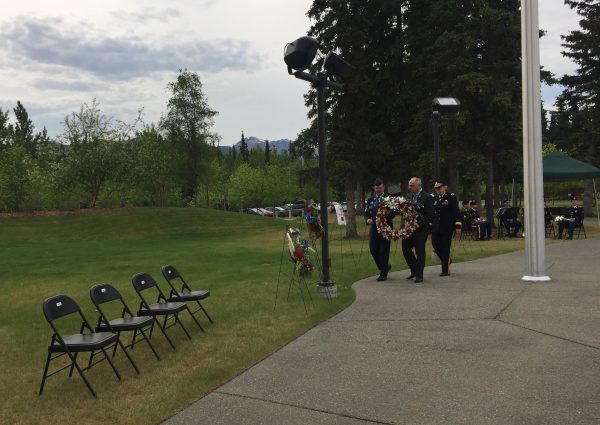
75 years ago this month, the Japanese Navy launched an air-raid on Dutch Harbor, and shortly afterwards invaded two islands at the tail end of the Aleutian chain. In the aftermath, 881 Unangax were hastily evacuated from their villages, shipped away in small boats to live in abysmal camp conditions in Southeast Alaska until the end of the war. On Friday (June 9th), a group of military officials, foreign dignitaries, and survivors gathered at the Fort Richardson National Ceremony to remember the events.
That morning, patchy clouds hung over a grassy lawn uniformly dotted with white grave markers. A brass band played, and soldiers in dress uniforms practiced rifle drills. A few dozen folding chairs faced a podium while a flag the size of a garage door flapped at half-mast.
“Please be seated,” said retired Air Force Colonel Suellyn Novak, the master of ceremonies during an hour-long event honoring everyone affected during the Aleutian campaign.
Novak is also the executive director of the state’s Veteran’s Museum, and painted a vivid historical picture of just how dramatically the then-territory was transformed by the conflict.
“Alaska was a military backwater. With obsolete air craft, no navy to speak of, and few troops until just after Pearl Harbor,” she explained in opening remarks.
The bombing of Dutch Harbor and Unalaska changed that. That attack prompted a massive military build-up and modernization effort, including construction of the ALCAN highway to facilitate sending Lend-Lease equipment to the Soviet Union, as well as the formation of the Alaska Territorial Guard.
On hand at the ceremony was Masatoshi Sato, of Japan’s Consular Office in Anchorage, who spoke of just how drastically relations between his country and Alaska have changed in the decades since the war.
“While we continue to look towards the future, it is important to remember the past, to avoid repeating the mistakes that cost the lives of so many,” Sato read from the podium.
Among those mistakes was the U.S. government’s internment of well over a 100,000 people of Japanese descent, the majority of them citizens living on the West Coast, including Alaska. Not far from the location of this national cemetery, Fort Richardson briefly had a small camp that held men of Japanese, German, and Italian ancestry.
And though they were evacuated under the pretense of safety, nearly a thousand Unangan people from the Aleutian islands were held in derelict camps scattered across Southeast.
Marie Matsuno Nash is with the Japanese-American Citizens League, and has family ties to both the Aleutians and Japan. Her parents were put in an internment camp out of state, where she was born.
“The Alaskans who were interred in those camps, as well as the Aleuts who were sent to camps in Southeastern Alaska, share a common history of forced removal from their homes,” Nash said during the ceremony.
One of those evacuees is 91-year-old George Gordaoff. He was 16 the night of the Japanese attack.
“I left Unalaska the night before the bombing,” Gordaoff recalled at a luncheon held after the commemoration.
He’d been ferrying supplies to a nearby island, and watched Japanese planes streaming overhead, many of them smoking from bullet strikes from anti-aircraft guns. In the days after, Gordaoff was packed onto a boat for evacuation.
“It was scary. Everything was scary. We didn’t know where they were taking us,” he said.
They were brought to a government school a few miles outside of the town of Wrangell. The hundreds of people were more than the building could accommodate. Eventually, Gordaoff and others slept in Army tents put out on the lawn. He worked as a cook.
“Thing was, there was nothing to cook!” he said. It was summer, and the school was closed. There were canned vegetables, but nothing substantial like fish or meat. “Except bacon. We had two big boxes of bacon. So (we added) bacon for everything.”
Gordaoff eventually joined the Army, but didn’t return to Unalaska after the war.
As the ceremony ended, National Guardsmen fired a rifle solute, remembrance wreaths were lain, and Marie Matsuno Nash, the woman born in an internment camp, handed out folded paper cranes to every member of the audience as a sign of peace.
Zachariah Hughes reports on city & state politics, arts & culture, drugs, and military affairs in Anchorage and South Central Alaska.
@ZachHughesAK About Zachariah




